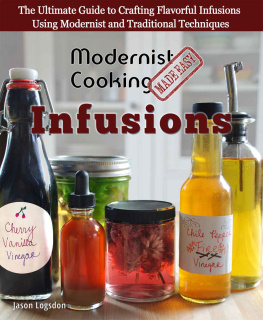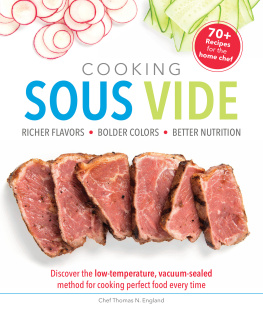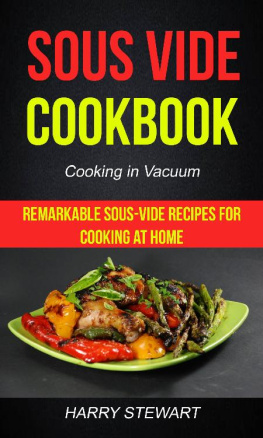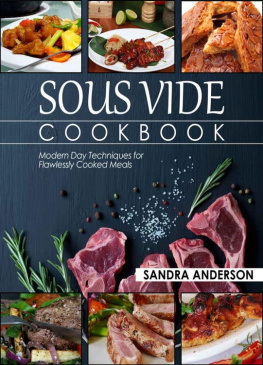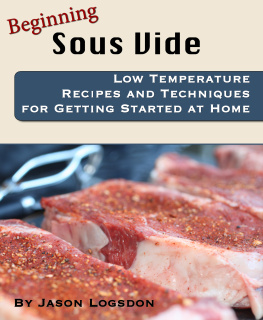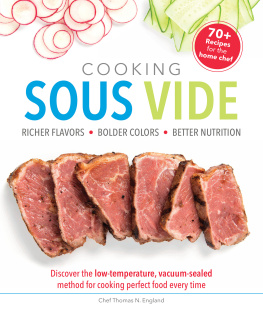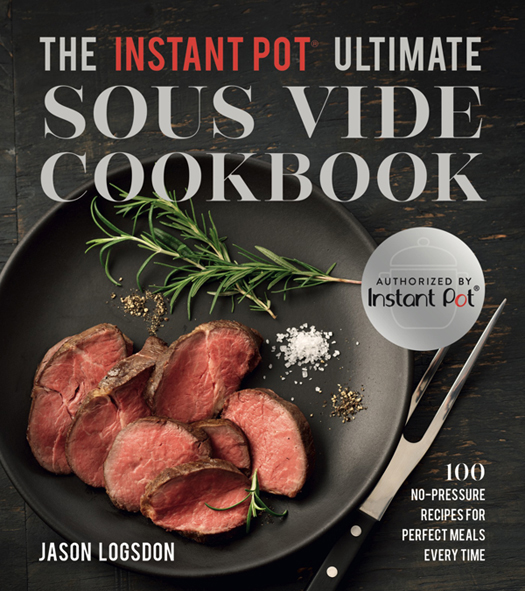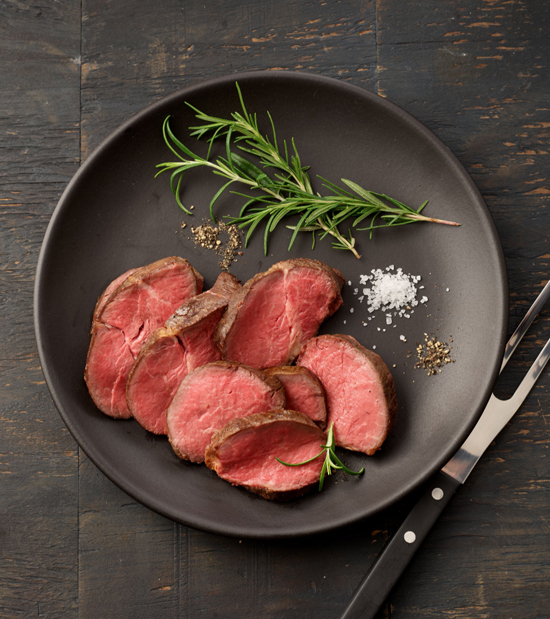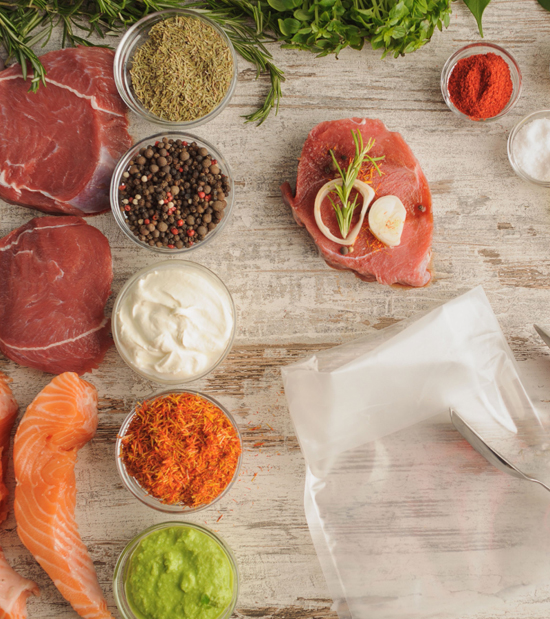STERLING EPICURE is a registered trademark and the distinctive Sterling Epicure logo is a trademark of Sterling Publishing Co., Inc.
Cover 2018 Sterling Publishing Co., Inc.
All rights reserved. No part of this publication may be reproduced, stored in a retrieval system, or transmitted in any form or by any means (including electronic, mechanical, photocopying, recording, or otherwise) without prior written permission from the publisher.
INSTANT POT is a registered trademark and the distinctive Instant Pot logo is a trademark of Double Insight, Inc. and is used with permission of Double Insight, Inc.
For information about custom editions, special sales, and premium and corporate purchases, please contact Sterling Special Sales at 800-805-5489 or .
INTRODUCTION
Sous Vide Overview
Sous vide can be intimidating when you approach it for the first time, but once you understand a few key concepts you realize how easy it is to use. Whether you are looking to make convenient everyday meals that taste great, or you want to up your gourmet game and seriously impress your friends and family, sous vide is an amazing tool to have in your cooking toolbox.
Just Getting Started?
Trying to decide how much information to include about sous vide is always a tough decision for me. I dont want to leave new people out in the cold and confused about how sous vide works, but I also dont want to fill up space that experienced sous viders will skip over.
As a compromise, this book offers a brief overview of how sous vide works and then provides links to my free online articles that examine these topics in greater detail. That way the novice sous vide cook can get up to speed while the experts can jump right to the recipes. So keep an eye out for the Notes blocks that will have links to more information.
And if you are really unsure about how sous vide works, I recommend my free email course, which will walk you through the entire process from start to finish at AFMEasy.com/SExplore .
Sous Vide Steps
When sous viding food, you almost always follow the same process.
The first step is to trim and season your food, just as you normally do in traditional cooking. Many of the same seasonings can be used, including spice rubs and most herbs. I usually salt my food before sous viding it, though many people omit that step for longer cooking times. The only big difference is that aromatics, like raw garlic and onion, are usually not used because they will not break down with the lower temperatures used in sous vide.
The second step is to determine the time and temperature at which you want to cook your food. If you are following a recipe, this information should be provided. If you are cooking something without a recipe, you can use the charts starting on page 151 to figure it out for other foods.
The third step is to enclose your food to protect it during the sous vide process. This is usually done by sealing it in plastic sous vide bags, but some recipes use canning jars or other vessels. Most of the sealing is done using a vacuum sealer or Ziploc Brand freezer bags.
Fourth, you place the bags in a water bath that is held to the specific temperature you decided on and let them cook for a set amount of time.
Finally, once the food is cooked, you remove it from the water bath and the bag, and normally finish it off by searing. Once youve gone through the process a handful of times, itll become second nature to you! The food coming out of the sous vide water bath can be very hot, especially for food cooked to a high temperature. Always handle hot foods carefully. It is usually best to handle the bags and food like you would any type of heated food, by using tongs, spatulas, and even oven mitts when needed.
Sous Vide Safety
Before moving into other areas of the sous vide process, I want to talk about sous vide safety. The main areas we will look at are the Danger Zone, Temperature versus Time, and Plastic Safety.
Keep in mind that sous vide is no more or less safe than other methods of cooking. Theres a lot of talk about the danger of cooking food sous vide, but its just as easy to make yourself sick by undercooking a chicken in the oven or undercooking grilled pork. So dont be intimidated: Once you know a few rules of thumb, youll be all set. And what you learn for sous vide can also be applied to make all your cooking safer.
DANGER ZONE
If there is one takeaway about food safety, it is understanding the danger zone.
The bacteria we are trying to remove during cooking thrive from around 40F (4.4C) to 126F (52.2C). They stop growing, but dont start dying quickly, until around 130F (54.4C). That range between 40F (4.4C) and 126F (52.2C) is known as the danger zone (cue Top Gun music) and its often referred to in food safety circles.
The longer food is held in the danger zone, the more likely you are to get sick from it. Most government agencies suggest that anything less than 4 hours is safe. Longer than that, it depends on what your tolerance for risk is, and whether or not you are serving it to people with immunodeficiencies.
TEMPERATURE VERSUS TIME
When people start with sous vide, they are often confused as to why it is suddenly okay to cook chicken or pork to an internal temperature of 140F (60C), when traditionally it has to be cooked to a much higher temperature.
We have always been taught that temperature is what makes food safe, but thats only half the equation. What makes food safe is actually a combination of the temperature it is heated to and the length of time it is held at that temperature. That time and temperature combine to pasteurize the food, making it safe to eat.
A piece of chicken heated to 140F (60C) and held there for 30 minutes is actually just as safe as one heated to 165F (73.9C) for 1 second. The reason the government suggests such a high temperature is that the pathogens are killed instantly at that temperature, but the same levels of pasteurization occur at much lower temperatures over longer periods. Using sous vide allows you to take advantage of this, since food cooked to lower temperatures results ends up being much moister.
PLASTIC SAFETY
A main concern of sous vide safety is cooking in plastic and whether or not this is a dangerous practice. Most scientists and chefs believe that cooking in food-safe, BPA-free plastic at these low temperatures does not pose any risk. The temperature is about equivalent to leaving a bottle of water in your car, or in a semi-truck during transport, in the summer. This includes Ziploc freezer bags, sous vide bags, and most food-safe plastics.


